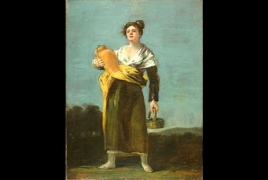Research reveals major discoveries in Goya masterpiece "La Aguadora" February 11, 2016 - 16:31 AMT PanARMENIAN.Net - A groundbreaking, four-year global research effort has resulted in major discoveries regarding Francisco de Goya’s renowned painting, La Aguadora (c. 1808), which has been in a private collection in Japan and out of public view for 40 years, Art Daily reports. The research, which included a an insightful examination of the painting’s iconography; an historical study of primary sources in Spain; a comprehensive investigation of the painting’s provenance; and state-of-the-art scientific analysis, proves for the first time that the model for the famed painting is Maria Agustin, a popular heroine in Spain at the time of the Napoleonic invasion. In addition, convincing circumstantial evidence shows that Goya likely painted the masterpiece while traveling in Spain to document the Napoleonic invasion. The research also provides insight into Goya’s political views and the powerful political meaning of the painting, which the painter suppressed in his own lifetime. Part of a private collection in Japan, for the four decades La Aguadora had been kept in a Tokyo warehouse. The painting, which Goya kept until his death, was purchased with other fine art in 1974 by a group of prominent Japanese businessmen – led by Ichiro Tsuboi – who were instrumental in revitalizing the Japanese economy after World War II. In the years after the masterpiece was stored, it became something of mystery. Kazutaka Tsuboi, the son of Ichiro Tsuboi who inherited the painting, launched a research project to learn more about the origins of La Aguadora in Japan. Mr. Tsuboi directed a worldwide team of experts, including his business partner Yuriko Reyes, art consultant Stefan Horsthemke from the premier art consulting firm Artbridge, located in Cologne, Germany, and Japanese art expert Kyoko Kazuse, to conduct a comprehensive review of the painting. The results were unexpected and very important in the world of Goya studies. “Our global research effort has deepened our understanding of La Aguadora, and also of the Spanish master, Goya,” said Ms. Reyes. “It has given La Aguadora a true rebirth and restored the painting to its rightful place as a major work of art that embodies the human spirit’s strength to overcome tyranny and oppression, the universal struggle for human rights and freedom that rings true today.” Stefan Horsthemke of Artbridge assembled a team of leading organizations for the research work. Fine Arts Experts Institute (FAEI), Geneva, conducted a thorough technological examination of the painting’s pigments. The Cologne Institute for Conservation Sciences (CICS) and FAEI undertook a detailed analysis of the painting process and canvas. “This extensive research project reads like a detective story and includes efforts from teams all over the world – in Paris, London, Madrid, Zaragoza, Cologne, Tokyo and New York,” said Mr. Horsthemke. “This journey has led to major iconographic and historical findings that greatly deepen our understanding of La Aguadora, the artist’s choice of his model, and demonstrate how Francisco de Goya used his art not only to document current events, in this case the horrors of wartime Zaragoza during the Napoleonic War, but also to elevate the imagery to mythic levels.” The pioneering historical research has for the first time identified the woman in La Aguadora. The research proves that the model for the woman in the Goya masterpiece is an actual individual, Maria Agustin, who was a popular heroine in Spain at the time of the Napoleonic invasion. However, when Goya painted La Aguadora, he idealized the image of Maria Agustin and transformed her into an archetype of the kind of women who supported the Spanish troops on the battlefield during the war with the French. The new research into La Aguadora also shows that the woman painted by Goya is carrying brandy, not water, as was previously thought for generations. Maria Agustin carried brandy to the Spanish troops on the battlefields, was depicted by other artists and writers, and was well known to the Spanish public. During the period, Maria Agustin embodied the Spanish resistance to French oppression. It has been established that in 1808, Goya, by this time deaf, traveled to Zaragoza to gather firsthand information about the Spanish resistance to the French invasion. Researchers believe there is strong circumstantial evidence to conclude that the artist created La Aguadora, which was painted very quickly and boldly, while traveling in Spain. The artist produced numerous paintings and sketches during his trip, some of which were destroyed by French soldiers and supporters, and others which he over-painted to protect them because of their anti-French and pro-Spanish content. From the time of this trip to Zaragoza and because of the French victory over the Spanish, Goya purposely never acknowledged the underlying political message or context of La Aguadora, in particular because he served a French court painter. As a result, the painting’s message has been misunderstood for generations. The creative crew of the Public TV had chosen 13-year-old Malena as a participant of this year's contest. She called on others to also suspend their accounts over the companies’ failure to tackle hate speech. Penderecki was known for his film scores, including for William Friedkin’s “The Exorcist”, Stanley Kubrick’s “The Shining”. The festival made the news public on March 19, saying that “several options are considered in order to preserve its running” Partner news |